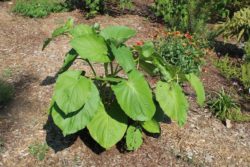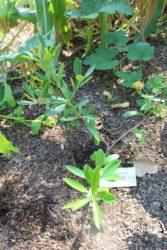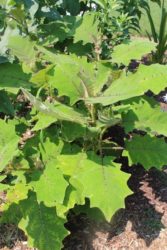
The Vanderbilt community is invited to explore the new Latin American ethnobotanical garden, which features 49 of the most culturally significant plants from the region, at a grand opening reception Thursday, Sept. 7, from 4:30 to 6 p.m.
The Latin American Garden is located between Natchez Field and 31st Avenue North, adjacent to Lot 73A, and is sponsored by the Vanderbilt Center for Latin American Studies (CLAS).

“It is hard to imagine a cuisine without New World foods: corn and potatoes, chocolate and chile, quinoa and tomatoes. Our diets are filled with foods indigenous to the Americas, and many of these plants also have medicinal uses dating back to pre-Colombian cultures,” said Avery Dickins de Girón, executive director of the Center for Latin American Studies and senior lecturer in anthropology.
The species selected reflect CLAS’ particular research strengths in Mexico, Central America, Brazil, the Andes, and the Black Atlantic regions. The garden contains a sage section, an agave section and an annual section, which features important food crops like amaranth, corn, squash and beans.
“One of our center’s most important missions is to connect the exciting research and scholarship on campus to our teaching and public outreach,” said Ted Fischer, director of the Center for Latin American Studies and Cornelius Vanderbilt Professor of Anthropology. “With a growing concern about where our food comes from and a growing recognition that we have a lot to learn from indigenous people about sustainability and plant biology, the garden is a great example of how an abstract trans-institutional idea can become a physical reality.”

The garden, which is in a pilot phase this year to see how well these plants adapt to Nashville’s climate, is the focus of a first-year iCommons Seminar taught by Dickins de Girón. Once fully established, it will serve as a multidisciplinary teaching tool.
“The Latin American Garden will allow us to explore the relationships between people and plants and will provide a starting point for discussions of history and global expansion, politics and economics, diet and health, biochemistry and pharmacology,” Dickins de Girón said. “We will use the garden as a microcosm into all of these issues, a way of literally grounding coursework and discussions on a variety of topics and disciplines in Arts in Science as well as the schools of Nursing and Medicine, Peabody College, and to enhance our center’s kindergarten-to-college educational outreach.”
As a federally designated National Resource Center for Latin American Education, the Center for Latin American Studies has a robust outreach program that reaches educators in Metro Nashville Schools and throughout the Southeast. The Latin American Garden will serve as a “lending garden” for Metro schools that wish to expand their gardens.

CLAS will offer a professional development workshop prior to the reception Sept. 7 that will focus on a few plants native to Mesoamerica and important in Aztec culture that are now noted for their high nutritional value: chia, amaranth and chocolate. The workshop will include a presentation by TSU professor of agronomics Matthew Blair, whose research on plant genetics targets improving the nutritional efficiency of beans and amaranth.
University landscape architect Robert Waits worked with CLAS to select the location of the garden and helped shepherd the proposal for its approval. Grounds manager Danny McKissack and university horticulturist Laura Barker were instrumental in the establishment of the garden and providing botanical advice. The University of Georgia’s Latin American and Caribbean Institute donated the majority of the plants to CLAS, and the amaranth plants were donated by TSU agronomist Blair.